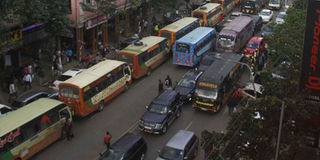Metropolitan transport body a solution to city’s perennial woes

Traffic jam on Moi Avenue in Nairobi on May 12, 2017. Major cities have adopted the Intelligent Transportation System ease transportation. PHOTO | MARTIN MUKANU | NATION MEDIA GROUP
What you need to know:
- Road traffic injuries cost low and middle-income countries between one and two per cent of their gross national products
- Singapore has developed modern toll roads to enter the most congested city centre areas.
The Cabinet’s recent approval of the formation of a metropolitan authority to control transport operations in Nairobi and its environs, the Nairobi Area Metropolitan Transport Authority, is laudable.
A large urban population, coupled with high economic activity, poses a major challenge to the traditional protocols of transport operations and accounts for the high accident rates and traffic jams.
Road traffic injuries cost low and middle-income countries between one and two per cent of their gross national products – figures that translate into more than the total development aid received by them.
TRAFFIC SNARL-UP
Preliminary research findings indicate that up to 80 per cent of motor vehicle crashes involve drivers who could avoid this with prompt alerts on imminent hazards.
Similarly, traffic jams impose heavy costs on national economies through delayed deliveries and missed opportunities.
Such conditions can be tamed by well-thought-out ideas implemented by a dedicated authority ready to adopt emerging technology.
Wireless communication technologies configured as vehicular communications aim to prevent accidents and traffic jams.
SAFETY SYSTEMS
The concept of road safety is addressed in the Intelligent Transportation System (ITS), which aims to integrate air, rail and road transport for safe and efficient travel, traffic de-congestion, real-time traffic information, electronic toll collection and Internet connectivity.
Passive safety systems such as seat belts, air bags and the anti-lock braking systems have been used as part of the ITS to reduce fatal accidents but the overall results have been minimal.
Currently, the active safety systems embedded in vehicular communications prevent accidents and enhance traffic efficiency with the help of wireless communication technologies.
TRAFFIC CONTROL
Major cities have adopted the ITS to ease transportation.
The US Department of Transport has been at the leading edge of technology development, which has since spread worldwide.
In the City of Bangkok (Thailand), railway lines (sky trains and subways), rapid transit road systems, public buses, airport express rail links, river boats and rickshaws (tuk tuks) form an integrated urban transport system with control centre operations based on wireless communication technologies to synchronise operations to guarantee safe and efficient transport, under the control of a metropolitan transport authority.
Synchronised sensor networks support traffic control at interchanges for optimal flow and management of congestion statistics.
And in Singapore, the transport system is mainly land-based, with many places accessible by road, railway and ferryboat services connecting the main island to the other islands.
TOLL COLLECTION
Rail transport consists of the Mass Rapid Transit (MRT) that runs the length and width of Singapore and the Light Rail Transit (LRT) within a few neighbourhoods.
Co-ordinated by the Land Transport Authority, Singapore has developed modern toll roads to enter the most congested city centre areas.
The Singapore Licensing Scheme has since been replaced with the Electronic Road Pricing, a form of electronic toll collection based on wireless communication technologies.
These technologies have enabled the operation of a safe, efficient and environmentally friendly transportation system in the metropolitan city.
ECONOMIC GROWTH
By selecting top-notch technologies in a well-coordinated research-based philosophy, the Nairobi Area Metropolitan Transport Authority can, if properly implemented, revolutionise transport operations in the city and its outlying counties.
This will go a long way in unlocking the economic potential of not only the cosmopolitan region and the nation, at large, but also the entire East and Central African region, whose main transport artery traverses Nairobi.
Dr Nyongesa is an expert in intelligent transportation systems. [email protected].




